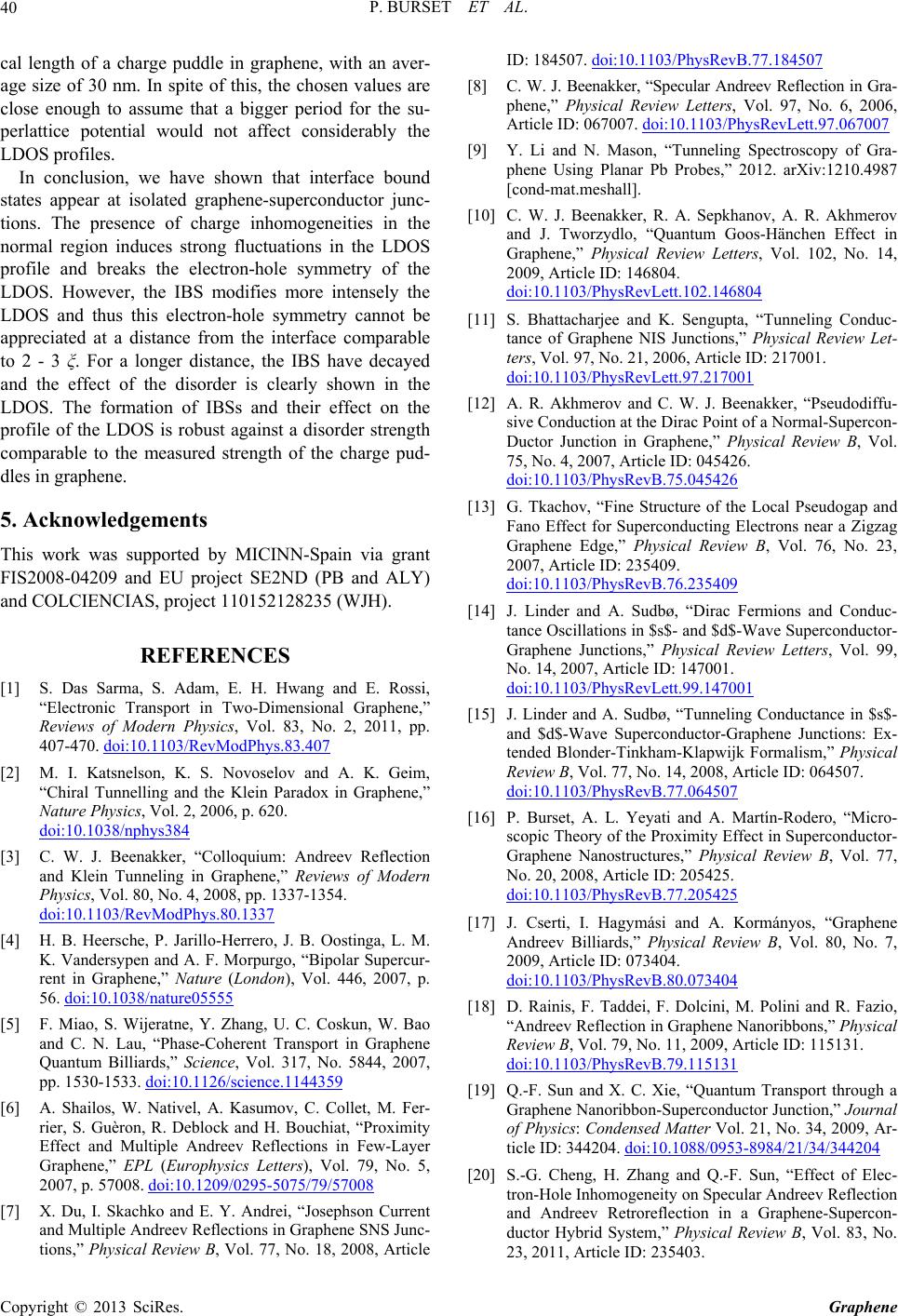
P. BURSET ET AL.
40
cal length of a charge puddle in graphene, with an aver-
age size of 30 nm. In spite of this, the chosen values are
close enough to assume that a bigger period for the su-
perlattice potential would not affect considerably the
LDOS profiles.
In conclusion, we have shown that interface bound
states appear at isolated graphene-superconductor junc-
tions. The presence of charge inhomogeneities in the
normal region induces strong fluctuations in the LDOS
profile and breaks the electron-hole symmetry of the
LDOS. However, the IBS modifies more intensely the
LDOS and thus this electron-hole symmetry cannot be
appreciated at a distance from the interface comparable
to 2 - 3 ξ. For a longer distance, the IBS have decayed
and the effect of the disorder is clearly shown in the
LDOS. The formation of IBSs and their effect on the
profile of the LDOS is robust against a disorder strength
comparable to the measured strength of the charge pud-
dles in graphene.
5. Acknowledgements
This work was supported by MICINN-Spain via grant
FIS2008-04209 and EU project SE2ND (PB and ALY)
and COLCIENCIAS, project 110152128235 (WJH).
REFERENCES
[1] S. Das Sarma, S. Adam, E. H. Hwang and E. Rossi,
“Electronic Transport in Two-Dimensional Graphene,”
Reviews of Modern Physics, Vol. 83, No. 2, 2011, pp.
407-470. doi:10.1103/RevModPhys.83.407
[2] M. I. Katsnelson, K. S. Novoselov and A. K. Geim,
“Chiral Tunnelling and the Klein Paradox in Graphene,”
Nature Physics, Vol. 2, 2006, p. 620.
doi:10.1038/nphys384
[3] C. W. J. Beenakker, “Colloquium: Andreev Reflection
and Klein Tunneling in Graphene,” Reviews of Modern
Physics, Vol. 80, No. 4, 2008, pp. 1337-1354.
doi:10.1103/RevModPhys.80.1337
[4] H. B. Heersche, P. Jarillo-Herrero, J. B. Oostinga, L. M.
K. Vandersypen and A. F. Morpurgo, “Bipolar Supercur-
rent in Graphene,” Nature (London), Vol. 446, 2007, p.
56. doi:10.1038/nature05555
[5] F. Miao, S. Wijeratne, Y. Zhang, U. C. Coskun, W. Bao
and C. N. Lau, “Phase-Coherent Transport in Graphene
Quantum Billiards,” Science, Vol. 317, No. 5844, 2007,
pp. 1530-1533. doi:10.1126/science.1144359
[6] A. Shailos, W. Nativel, A. Kasumov, C. Collet, M. Fer-
rier, S. Guèron, R. Deblock and H. Bouchiat, “Proximity
Effect and Multiple Andreev Reflections in Few-Layer
Graphene,” EPL (Europhysics Letters), Vol. 79, No. 5,
2007, p. 57008. doi:10.1209/0295-5075/79/57008
[7] X. Du, I. Skachko and E. Y. Andrei, “Josephson Current
and Multiple Andreev Reflections in Graphene SNS Junc-
tions,” Physical Review B, Vol. 77, No. 18, 2008, Article
ID: 184507. doi:10.1103/PhysRevB.77.184507
[8] C. W. J. Beenakker, “Specular Andreev Reflection in Gra-
phene,” Physical Review Letters, Vol. 97, No. 6, 2006,
Article ID: 067007. doi:10.1103/PhysRevLett.97.067007
[9] Y. Li and N. Mason, “Tunneling Spectroscopy of Gra-
phene Using Planar Pb Probes,” 2012. arXiv:1210.4987
[cond-mat.meshall].
[10] C. W. J. Beenakker, R. A. Sepkhanov, A. R. Akhmerov
and J. Tworzydlo, “Quantum Goos-Hänchen Effect in
Graphene,” Physical Review Letters, Vol. 102, No. 14,
2009, Article ID: 146804.
doi:10.1103/PhysRevLett.102.146804
[11] S. Bhattacharjee and K. Sengupta, “Tunneling Conduc-
tance of Graphene NIS Junctions,” Physical Review Let-
ters, Vol. 97, No. 21, 2006, Article ID: 217001.
doi:10.1103/PhysRevLett.97.217001
[12] A. R. Akhmerov and C. W. J. Beenakker, “Pseudodiffu-
sive Conduction at the Dirac Point of a Normal-Supercon-
Ductor Junction in Graphene,” Physical Review B, Vol.
75, No. 4, 2007, Article ID: 045426.
doi:10.1103/PhysRevB.75.045426
[13] G. Tkachov, “Fine Structure of the Local Pseudogap and
Fano Effect for Superconducting Electrons near a Zigzag
Graphene Edge,” Physical Review B, Vol. 76, No. 23,
2007, Article ID: 235409.
doi:10.1103/PhysRevB.76.235409
[14] J. Linder and A. Sudbø, “Dirac Fermions and Conduc-
tance Oscillations in $s$- and $d$-Wave Superconductor-
Graphene Junctions,” Physical Review Letters, Vol. 99,
No. 14, 2007, Article ID: 147001.
doi:10.1103/PhysRevLett.99.147001
[15] J. Linder and A. Sudbø, “Tunneling Conductance in $s$-
and $d$-Wave Superconductor-Graphene Junctions: Ex-
tended Blonder-Tinkham-Klapwijk Formalism,” Physical
Review B, Vol. 77, No. 14, 2008, Article ID: 064507.
doi:10.1103/PhysRevB.77.064507
[16] P. Burset, A. L. Yeyati and A. Martín-Rodero, “Micro-
scopic Theory of the Proximity Effect in Superconductor-
Graphene Nanostructures,” Physical Review B, Vol. 77,
No. 20, 2008, Article ID: 205425.
doi:10.1103/PhysRevB.77.205425
[17] J. Cserti, I. Hagymási and A. Kormányos, “Graphene
Andreev Billiards,” Physical Review B, Vol. 80, No. 7,
2009, Article ID: 073404.
doi:10.1103/PhysRevB.80.073404
[18] D. Rainis, F. Taddei, F. Dolcini, M. Polini and R. Fazio,
“Andreev Reflection in Graphene Nanoribbons,” Physical
Review B, Vol. 79, No. 11, 2009, Article ID: 115131.
doi:10.1103/PhysRevB.79.115131
[19] Q.-F. Sun and X. C. Xie, “Quantum Transport through a
Graphene Nanoribbon-Superconductor Junction,” Journal
of Physics: Condensed Matter Vol. 21, No. 34, 2009, Ar-
ticle ID: 344204. doi:10.1088/0953-8984/21/34/344204
[20] S.-G. Cheng, H. Zhang and Q.-F. Sun, “Effect of Elec-
tron-Hole Inhomogeneity on Specular Andreev Reflection
and Andreev Retroreflection in a Graphene-Supercon-
ductor Hybrid System,” Physical Review B, Vol. 83, No.
23, 2011, Article ID: 235403.
Copyright © 2013 SciRes. Graphene